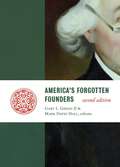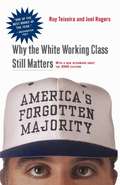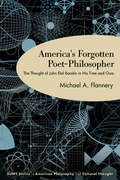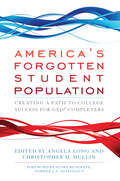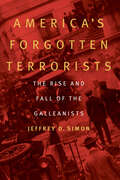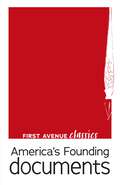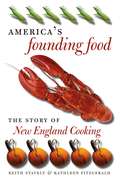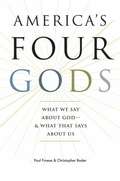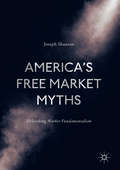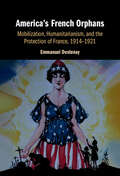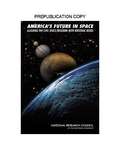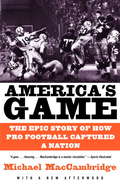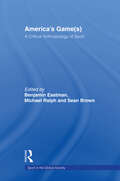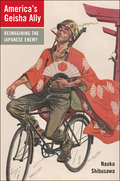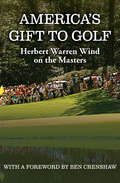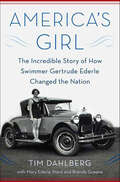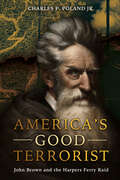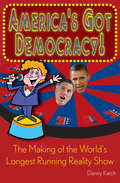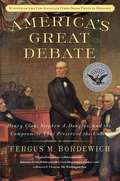- Table View
- List View
America's Forgotten Founders, second edition (Lives of the Founders)
by Mark David Hall Gary L. GreggBeyond Washington and Jefferson: Ranking the Founders. Even as Americans devour books about our Founding Fathers, the focus seldom extends past a half dozen or so icons—Franklin, Washington, Adams, Jefferson, Madison, Hamilton. Many of the men (and women) who made prodigious contributions to the American founding have been all but forgotten. America's Forgotten Founders corrects this injustice. Editors Gary L. Gregg II and Mark David Hall surveyed forty-five top scholars in history, political science, and law to produce the first-ever ranking of the most neglected contributors to the American Revolution and our constitutional order. This unique book features engaging short biographies of the top ten most important Founders whose contributions are overlooked today: James Wilson, George Mason, Gouverneur Morris, John Jay, Roger Sherman, John Marshall, John Dickinson, Thomas Paine, Patrick Henry, and John Witherspoon. Part of the "Lives of the Founders" series, America's Forgotten Founders reshapes our understanding of America's founding generation.
America's Forgotten Majority: Why the White Working Class Still Matters
by Ruy Teixeira Joel RogersA powerful look at the real America, dominated by America's "forgotten majority"-white working-class men and women who make up 55 percent of the voting population
America's Forgotten Pandemic
by Alfred W. CrosbyBetween August 1918 and March 1919 the Spanish influenza spread worldwide, claiming over 25 million lives, more people than those perished in the fighting of the First World War. It proved fatal to at least a half-million Americans. Yet, the Spanish flu pandemic is largely forgotten today. In this vivid narrative, Alfred W. Crosby recounts the course of the pandemic during the panic-stricken months of 1918 and 1919, measures its impact on American society, and probes the curious loss of national memory of this cataclysmic event. In a new edition, with a new preface discussing the recent outbreaks of diseases, including the Asian flu and the SARS epidemic, America's Forgotten Pandemic remains both prescient and relevant. Alfred W. Crosby is a Professor Emeritus in American Studies, History and Geography at the University of Texas at Austin, where he taught for over 20 years. His previous books include Throwing Fire (Cambrige, 2002), the Measure of Reality (Cambridge, 1997) and Ecological Imperialism (cambridge, 1986). Ecological Imperialism was the winner of the 1986 Phi Beta Kappa book prize. The Measure of Reality was chosen by the Los Angeles Times as one of the 100 most important books of 1997.
America's Forgotten Poet-Philosopher: The Thought of John Elof Boodin in His Time and Ours (SUNY series in American Philosophy and Cultural Thought)
by Michael A. FlanneryThis book examines the ideas and influences of a nearly forgotten Swedish-American philosopher, John Elof Boodin (1869–1950). A friend and student of William James and protégé of Josiah Royce at Harvard, Boodin combined Jamesian pragmatism and Roycean idealism in developing original scholarship (nearly sixty articles and eight books) from 1900 to 1947, in addition to a volume of posthumous papers published in 1957. Although he is seldom remembered today, the enduring importance of pragmatism and the rising influence of process theology today suggests that his close reading of early to mid-twentieth-century science and vast grasp of philosophical issues warrants a renewed interest in his work that can be a valuable antidote to the sterile and constricting effects of reductionism and dogmatic materialism prevalent today in both those fields.
America's Forgotten Student Population: Creating a Path to College Success for GED® Completers
by Christopher M. Mullin Angela LongConstituting one in twelve of adult Americans, GED certificate holders comprise a major pool of underdeveloped human capital in our society. They are a resource that will be sorely needed as “boomers” reach retirement and the traditional pipeline of 17 – 23 year olds falls short of filling our growing workforce needs. Although these nontraditional students can potentially meet our future workforce demands, and although half of them enter post-secondary education, half of those who do so drop out of college for lack of basic support systems – often at the very same institutions that provided programs of retention while they were earning their GED and completing basic Adult Education classes. Yet national data collected by the National Center for Educational Statistics reveals that GED certificate holders who persist to their second year of community college studies accumulate grade point averages equal to high school graduates, refuting widely held beliefs that GED earners are not capable of rigorous academic work. This is the first book to remedy the dearth of data on this forgotten population, to present original research on these students, describing their characteristics and motivations, and to provide proven models for identifying, retaining and graduating this under-counted and underestimated cohort. It addresses the issue of the pipeline from GED centers to postsecondary education, and includes first-person narratives that offer vivid insights into GED earners’ resilience and needs. As this book reveals, more than 40 percent of community colleges responding to a 2010 ACT survey have no one responsible for coordinating retention efforts; and more than half have no goals for first-year student retention; and estimates that community colleges are cumulatively foregoing over $1.5 billion in revenues as the result of failing to retain their GED populations.This book is a comprehensive resource for college administrators, and for educational policy makers and researchers, offering both broad policy recommendations and tested ideas and models that can be implemented at the state and institutional level.
America's Forgotten Terrorists: The Rise and Fall of the Galleanists
by Jeffrey D. SimonThough largely forgotten today, one of the most destructive terrorist groups in the United States was the Galleanists, a fiery band of Italian anarchists active during the early 1900s. In America&’s Forgotten Terrorists, Jeffrey D. Simon shows how alienation and frustration among segments of a community were transformed into a militant extremist movement. Luigi Galleani, a gifted writer and speaker, tapped into widespread disappointment among Italian immigrants concerning their lives in America. Unemployment, low wages, long working hours, discrimination, and a poor quality of life made many Italian immigrants receptive to his words. The Galleanists introduced terrorist tactics and strategies that are still used today: they were the first group to send package bombs across the country and to exploit the media for their own advantage. One of their members is also suspected of launching the first vehicle bomb in the United States in 1920, considered the worst act of domestic terrorism until the 1995 Oklahoma City bombing. The story of the Galleanists is a chilling journey through a volatile period in American history, including labor-management conflicts, World War I, and the Red Scare. An expert in terrorism, Simon offers striking insights into the Galleanist era and some of its eerie connections to modern America, calling us to recognize the risks of repeating our history. How the Galleanists operated and how the U.S. government responded hold lessons for today as we continue to deal with the threat of terrorism.
America's Fortress: A History of Fort Jefferson, Dry Tortugas, Florida (Florida History and Culture)
by Thomas ReidA little-known Civil War outpost that was the most heavily armed coastal defense fort in United States historyKnown as the “American Gibraltar,” Fort Jefferson, located in the Dry Tortugas, Florida, was the most heavily armed coastal defense fort in United States history. Perceived as the nation’s leading maximum-security prison, the fort also held several of the accused conspirators in the Lincoln assassination. America’s Fortress is the first book-length, architectural, military, environmental, and political history of this strange and significant Florida landmark. This volume also fills a significant gap in Civil War history with regard to coastal defense strategy, support of the Confederacy blockade, the use of convicted Union soldiers as forced labor, and the treatment of civilian prisoners sentenced by military tribunals. Reid argues that Fort Jefferson’s troops faced very different threats and challenges than soldiers who served elsewhere during the war. He chronicles threats of epidemic tropical disease, hurricanes, shipwrecks, prisoner escapes, and Confederate attack. Reid also reports on white northerners’ perceptions of enslaved people, slavery, and the emerging free black soldiers of the latter years of the war. Drawing on the writings of Emily Holder, wife of Fort Jefferson’s resident surgeon, Reid is the first to offer a female perspective on life at the fort between 1859 and 1865. For history buffs and tourists, America's Fortress offers a fascinating account of this little-known outpost which has stood for over 160 years off the tip of the Florida Keys.
America's Founding Documents: The Declaration of Independence, the Articles of Confederation, the United States Constitution, the Federalist Papers, and the Bill of Rights (First Avenue Classics ™)
by Alexander Hamilton James Madison John Jay Thomas JeffersonSoon after the start of the American Revolutionary War in 1775, the Thirteen Colonies proclaimed their independence from British rule and became the United States of America. The written word proved vital in shaping America's new identity, laying the groundwork for societal principles and political doctrine alike. From Thomas Jefferson and the members of the Second Continental Congress, to Alexander Hamilton, James Madison, and John Jay, the authors of these documents had a profound and lasting effect on United States history. This collection includes unabridged versions of five famous and influential documents that helped to found a nation: the Declaration of Independence (1776), the Articles of Confederation (1777), the United States Constitution (1787), the Federalist Papers (1787–1788), and the Bill of Rights (1791).
America's Founding Food
by Kathleen Fitzgerald Keith StavelyFrom baked beans to apple cider, from clam chowder to pumpkin pie, Keith Stavely and Kathleen Fitzgerald's culinary history reveals the complex and colorful origins of New England foods and cookery. Featuring hosts of stories and recipes derived from generations of New Englanders of diverse backgrounds, America's Founding Food chronicles the region's cuisine, from the English settlers' first encounter with Indian corn in the early seventeenth century to the nostalgic marketing of New England dishes in the first half of the twentieth century.Focusing on the traditional foods of the region--including beans, pumpkins, seafood, meats, baked goods, and beverages such as cider and rum--the authors show how New Englanders procured, preserved, and prepared their sustaining dishes. Placing the New England culinary experience in the broader context of British and American history and culture, Stavely and Fitzgerald demonstrate the importance of New England's foods to the formation of American identity, while dispelling some of the myths arising from patriotic sentiment. At once a sharp assessment and a savory recollection, America's Founding Food sets out the rich story of the American dinner table and provides a new way to appreciate American history.
America's Four Gods: What We Say about God -- And What That Says about Us
by Christopher Bader Paul FroeseThis text draws on the most wide-ranging, comprehensive, and illuminating survey of American's religious beliefs ever conducted to offer a systematic exploration of how Americans view God.
America's Free Market Myths: Debunking Market Fundamentalism
by Joseph ShaananThis book describes and refutes thirteen ideas involving free market principles and the US economic system, arguing that these (mostly familiar) ideas are myths. The myths are deeply ingrained in the United States' self-image and in political discourse, and are hailed as indisputable, scientifically grounded truths. Unfortunately, an economy dominated by giant corporations bears little resemblance to a free market. So why is so much effort and expense devoted to disseminating these stories? The answer is simple. The different myths generate the recommendation that the system's rewards should flow upward to corporations and a small group of wealthy and politically influential people. The myths help entrench existing economic and political power while distancing America from a more productive and widely beneficial form of capitalism.
America's French Orphans: Mobilization, Humanitarianism, and the Protection of France, 1914–1921
by Emmanuel DestenayDuring and after World War I, two humanitarian organizations galvanized the support of American men, women, and children to provide for France's children. Between 1914 and 1921, the Committee Franco-American for the Protection of the Children of the Frontier (CFAPCF) and the Fatherless Children of France Society (FCFS) capitalized on the generosity of Americans who believed that supporting a French child in need was seen as a moral and patriotic duty. Through a network of twenty-eight colonies – private homes and estates loaned for this specific purpose – the CFAPCF rescued, sheltered, and cared for children from invaded and occupied war zones, while the FCFS asked Americans to sponsor France's children of the war dead. Combining cultural, political, and diplomatic history, Emmanuel Destenay charts the rapid growth of these organizations and brings to light the unparalleled contribution made by Americans in support of France's children in time of war.
America's Frozen Neighborhoods: The Abuse of Zoning
by Robert C. EllicksonThis book examines local zoning policies and suggests reforms that states and the federal government might adopt to counter the negative effects of exclusionary zoning In this book, Robert Ellickson asserts that local zoning policies are the most consequential regulatory program in the United States. Many localities have created barriers to the development of less costly forms of housing. Numerous economists have found that current zoning practices inflict major damage on the national economy. Using Silicon Valley, the Greater New Haven area, and the northwestern portion of Greater Austin as case studies, Ellickson shows in unprecedented detail how the zoning system works and recommends steps for its reform. Zoning regulations, Ellickson demonstrates, are hard to dislodge once localities have enacted them. He develops metrics to measure the existence and costs of exclusionary zoning, and suggests reforms that states and the federal government could undertake to counter the detrimental effects of local policies. These include the cartelization of housing markets and the aggravation of racial and class segregation.
America's Future in Space: Aligning the Civil Space Program with National Needs
by National Research Council of the National AcademiesAs civil space policies and programs have evolved, the geopolitical environment has changed dramatically. Although the U.S. space program was originally driven in large part by competition with the Soviet Union, the nation now finds itself in a post-Cold War world in which many nations have established, or are aspiring to develop, independent space capabilities. Furthermore discoveries from developments in the first 50 years of the space age have led to an explosion of scientific and engineering knowledge and practical applications of space technology. The private sector has also been developing, fielding, and expanding the commercial use of space-based technology and systems. Recognizing the new national and international context for space activities, America's Future in Space is meant to advise the nation on key goals and critical issues in 21st century U.S. civil space policy.
America's Game
by Michael MaccambridgeIt's difficult to imagine today--when the Super Bowl has virtually become a national holiday and the National Football League is the country's dominant sports entity--but pro football was once a ramshackle afterthought on the margins of the American sports landscape. In the span of a single generation in postwar America, the game charted an extraordinary rise in popularity, becoming a smartly managed, keenly marketed sports entertainment colossus whose action is ideally suited to television and whose sensibilities perfectly fit the modern age.America's Game traces pro football's grand transformation, from the World War II years, when the NFL was fighting for its very existence, to the turbulent 1980s and 1990s, when labor disputes and off-field scandals shook the game to its core, and up to the sport's present-day preeminence. A thoroughly entertaining account of the entire universe of professional football, from locker room to boardroom, from playing field to press box, this is an essential book for any fan of America's favorite sport.From the Trade Paperback edition.n scope, America's Game is cultural history at its finest. A thoroughly entertaining account of the entire universe of professional football, from locker room to boardroom, from playing field to press box, it is a unique lens through which to view the past sixty years of American history.From the Hardcover edition.
America's Game: A Critical Anthropology of Sport (Sport in the Global Society)
by Benjamin Eastman, Michael Ralph and Sean BrownThis insightful volume considers how to locate America in the sporting world: in the traditions and rituals of a national pastime or in the baseball academies run by American professional teams in the Dominican Republic? With the athletes that carry a flag in Olympic ceremonies or among the executives in the boardrooms of Nike? The contributors arg
America's Game: The NFL at 100
by Jerry Rice Randy O. WilliamsA celebration of 100 years of the NFL from Hall of Fame receiver and bestselling author Jerry Rice!“This book is an amazing compilation of the game’s history as seen through the eyes of my friend Jerry Rice, aka The GOAT. You are going to love this book almost as much as you loved watching Jerry play!” —Barry Sanders, NFL Hall of Fame Class of 2004The authors of the New York Times bestseller 50 Years, 50 Moments celebrate the first 100 years of the National Football League, interweaving history, personal stories, memories, and observations of some of its greatest players, coaches, and advocates to chronicle football’s amazing evolution from a fledgling regional fly-by-night operation into a multi-billion global brand and one of America’s leading franchises.Over the past century, professional football has transformed from a game played in leather helmets on cow pastures to one of the most high-tech, popular sports on the planet. In this entertaining and concise history, Jerry Rice and Randy O. Williams celebrate the NFL’s centennial, bringing together colorful memories, insights, and personal experiences and observations from the heroes, losers, innovators, and defining legends who have played the game at its highest level. America's Game is filled with inside stories of the league’s fiercest rivalries, closest competitions, and most memorable characters, from the early days of Red “The Galloping Ghost” Grange and “Slingin’” Sammy Baugh to Jim Brown and “Broadway” Joe Namath to Lawrence Taylor, Jerry Rice, and Tom Brady.Cowboy fans will never forget how Roger Staubach’s Hail Mary lifted his team to a last-second playoff victory over the Vikings. Patriot followers will always point to The Tuck Rule Game as a franchise landmark where Adam Vinatieri’s two clutch kicks in deep snow propelled his team to victory over the Raiders. Generations of Steelers fans will celebrate James Harrison’s electrifying 100–yard interception return for a touchdown in Super Bowl XLIII. All are among the most memorable moments in NFL history. Divided by increments of twenty-five years, each section of America's Game includes the authors’ selections for their “All Star” players and teams.America's Game is a unique tribute to this enduring cultural phenomenon, and will become the authoritative tribute to all that is great about the sport Americans—and the world—loves.
America's Geisha Ally
by Naoko ShibusawaDuring World War II, Japan was vilified by America as our hated enemy. As the Cold War heated up, however, the U.S. government decided to make Japan its bulwark against communism in Asia. In this revelatory work, Naoko Shibusawa charts the remarkable reversal from hated enemy to valuable ally that occurred in the two decades after the war.
America's Gift to Golf: Herbert Warren Wind on the Masters
by Herbert Warren WindThe dean of American golf writers pays tribute to the nation&’s greatest tournament Over the course of his forty-year career at the New Yorker and Sports Illustrated, Herbert Warren Wind covered the game of golf from many different angles, providing readers with eloquent insights on the iconic courses of Scotland as well as Bing Crosby&’s lifelong love affair with the sport. But no aspect of golf was closer to Wind&’s heart, or more intimately associated with his name, than the annual Masters Tournament at Augusta National Golf Course. Recounting Arnold Palmer&’s victory in 1958, Wind coined the phrase &“Amen Corner&” to describe the fateful stretch of golf course including the 11th, 12th, and 13th holes. To celebrate the fiftieth anniversary of the first Augusta National Invitation, held in 1934, Wind eloquently recounted a half-century&’s worth of highlights, from Bobby Jones&’s original vision of an informal competition between his old friends and the game&’s rising stars, to Ben Crenshaw&’s impressive defeat of Tom Watson in the 1984 tournament. Full of the grand traditions—including green jackets, purple azaleas, and white jumpsuits—and dramatic moments that have made the Masters the most entertaining of the four major championships, America&’s Gift to Golf brings the history of this majestic tournament to vivid life and testifies to the enduring legacy of Herbert Warren Wind.
America's Girl: The Incredible Story of How Swimmer Gertrude Ederle Changed the Nation
by Tim Dahlberg Mary Ederle Ward Brenda GreeneAmerica's Girl is an intimate look at the life and trials of Gertrude Ederle, who in 1926 not only became the first woman to swim across the English Channel, but broke the record set by men. The feat so thrilled America that it welcomed her home with a ticker tape parade that drew two million people. This fascinating portrait follows Ederle from her early days as a competitive swimmer through her gold medal triumph at the 1924 Olympics, to the first attempt the next year by Ederle to swim from France to England in frigid and turbulent waters, a feat that had been conquered by only five men up to that time. This is also a stirring look at the go-go era of the 1920s, when the country was about to recognize that women not only could vote, but compete on an international scale as athletes. At the height of Prohibition, Ederle's triumph over the formidable Channel was a triumph for women everywhere. America's Girl immerses readers in a pivotal era of American history and brings to life the spirit of that time.
America's Good Terrorist: John Brown and the Harpers Ferry Raid
by Charles P. Poland Jr.<p>A biography of John Brown, examining his failed raid on Harpers Ferry, and the part his actions played in causing the Civil War.<p> <p>John Brown’s failed efforts at Harpers Ferry have left an imprint upon our history, and his story still swirls in controversy. Was he a madman who felt his violent solution to slavery was ordained by Providence or a heroic freedom fighter who tried to liberate the downtrodden slave? These polar opposite characterizations of the violent abolitionist have captivated Americans. The prevailing view from the time of the raid to well into the twentieth century—that his actions were the product of an unbalanced mind—has shifted to the idea that he committed courageous acts to undo a terrible injustice.<p> <p>Despite the differences between modern terrorist acts and Brown’s own violent acts, when Brown’s characteristics are compared to the definition of terrorism as set forth by scholars of terrorism, he fits the profile. Nevertheless, today Brown is a martyred hero who gave his life attempting to terminate the evil institution of human bondage. The modern view of Brown has unintentionally made him a “good terrorist,” despite the repugnance of terrorism that makes the thought of a benevolent or good terrorist an oxymoron.<p> <p>This biography covers Brown’s background and the context to his decision to carry out the raid, a detailed narrative of the raid and its consequences for both those involved and America; and an exploration of the changing characterization of Brown since his death.<p>
America's Got Democracy!: The Making of the World's Longest-Running Reality Show
by Danny KatchA humorous but passionate look at the criminal silliness of the US political system from the author who has &“better comic bomb sights than John Stewart&” (Mike Davis, author of The Monster at Our Door). In this raucous, irreverent book, Danny Katch diagnoses the various mental disorders peculiar to those who have way too much money and power—and the politicians who work for them. He shows how the very elections that are supposed to be our way of bringing about change have become a tool to get us to accept the insane status quo. &“The funniest, smartest, and most dangerous political writer you never heard of is Danny Katch. You&’ll laugh. You&’ll get pissed off. You&’ll disagree. And you&’ll wonder how you read this terrific book in one sitting. A welcome antidote to what passes for political writing in an election year.&” —Dave Zirin, author of Game Over: How Politics Has Turned the Sports World Upside Down &“From Cocoa Puffs to melting ice caps, Danny Katch&’s America&’s Got Democracy gets to the heart of how and why our political establishment creates economic, social, and environmental crapification, and he does it with a flair even the most disaffected café barista with a PhD will love. But if you enjoy reading dry, abstract political works in which the words go clopping across the page on little wooden feet, don&’t read Katch&’s book.&” —Sherry Wolf, author of Sexuality and Socialism &“Guess what? It&’s even more boringer reading it than talking about it.&” —Lila Katch, seven years old
America's Great Debate: Henry Clay, Stephen A. Douglas, and the Compromise That Preserved the Union
by Fergus M. BordewichThe Mexican War introduced vast new territories into the United States, among them California and the present-day Southwest. When gold was discovered in California in the great Gold Rush of 1849, the population swelled, and settlers petitioned for admission to the Union. But the U.S. Senate was precariously balanced with fifteen free states and fifteen slave states. Up to then states had been admitted in pairs, one free and one slave, to preserve that tenuous balance in the Senate. Would California be free or slave? So began a paralyzing crisis in American government, and the longest debate in Senate history. Fergus Bordewich tells the epic story of the Compromise of 1850 with skill and vigor, bringing to life two generations of senators who dominated the great debate. Luminaries such as John Calhoun, Daniel Webster, and Henry Clay—who tried unsuccessfully to cobble together a compromise that would allow for California’s admission and simultaneously put an end to the nation’s agony over slavery—were nearing the end of their long careers. Rising stars such as Jefferson Davis, William Seward, and Stephen Douglas—who ultimately succeeded where Clay failed—would shape the country’s politics as slavery gradually fractured the nation. The Compromise saved the Union from collapse, but it did so at a great cost. The gulf between North and South over slavery widened with the strengthened Fugitive Slave Law that was part of the complex Compromise. In America’s Great Debate Fergus Bordewich takes us back to a time when compromise was imperative, when men swayed one another in Congress with the power of their ideas and their rhetoric, when partisans on each side reached across the aisle to preserve the Union from tragedy.
America's Great Game: The CIA's Secret Arabists and the Shaping of the Modern Middle East
by Hugh WilfordThe Central Intelligence Agency’s reputation in the Middle East today has been marred by waterboarding and drone strikes, yet in its earliest years the agency was actually the region’s staunchest western ally. In America's Great Game, celebrated intelligence historian Hugh Wilford reveals how three colorful CIA operatives-Kermit and Archie Roosevelt, and maverick covert-ops expert Miles Copeland-attempted, futilely, to bring the U. S. and Middle East into harmony during the 1940s and '50s. Heirs to an American missionary tradition that taught them to treat Arabs and Muslims with respect and empathy, these CIA "Arabists” nevertheless behaved like political puppet-masters, orchestrating coup plots throughout the Middle East while seeking to sway public opinion in America against support for the new state of Israel. Their efforts, and ultimate failure, would doom U. S. -Middle Eastern relations for decades to come. Drawing on extensive new material, including declassified government records, private papers, and personal interviews, America's Great Game shows how three well-intentioned spies inadvertently ruptured relations between America and the Arab world.
America's Great Railroad Stations
by Roger Straus IIIAn evocative and stunning photographic tribute to America's railroad stations. For much of the nineteenth and early twentieth centuries, the railroad station or depot was the communal hub of every American town that could boast of train service. There, citizens gathered before they sent loved ones off to college, marriage, or war-and where they greeted them on their return. Most of these buildings were architectural gems, and while many are still in service, certain others now house museums, banks, restaurants, and more. In fact, in cities like Washington, D. C. , and Philadelphia, renovated stations are destinations unto themselves even for those not boarding the train. And in other places, whole sections of towns have been remade around these structures, restoring their vitality in novel and interesting ways long after the last train has left the station. In America's Great Railroad Stations, award-winning photographer Roger Straus III, and two lifelong railroad buffs, Ed Breslin and Hugh Van Dusen, join forces to tell the astonishing story of these enduring structures and the important role they still play in the country's landscape. Journeying from the Pennsylvania Railroad to the Union Pacific to Michigan Central and more, readers will be dazzled by the Beaux Arts monuments of New York and the adobe buildings of the Southwest. Filled with both new and archival photographs and drawings, this volume is a glorious salute to the institution that transformed our nation. .
